Manhattan Project

The Manhattan Project (Manhattan Project) is the code name for the US nuclear weapons program, which began on September 17, 1942. Prior to this, studies were conducted in the Uranium Committee (S-1 Uranium Committee, since 1939). Scientists from the United States of America, Great Britain, Germany and Canada took part in the project. The project created three atomic bombs: the plutonium "Trinity" (exploded during the first nuclear test), the uranium "Kid" (dropped on Hiroshima on August 6, 1945) and the plutonium "Fat Man" (dropped on Nagasaki on August 9, 1945).
Chronology of events.
On June 18, 1942, Colonel James Marshall (James Marshall) receives an order to organize a production base for combining the efforts of scientists and engineers to develop nuclear weapons. The new organization was created in August and was named “Manhattan Engeineer District”, later simply “The Manhattan Project”.
')
On September 17, 1942, Colonel Leslie Richard Groves was appointed Project Manager. Actually from this day and you can start counting the active phase of work that will continue for the next three years. Being an experienced adimistrator, after his appointment, Gruvs launched a stormy activity.
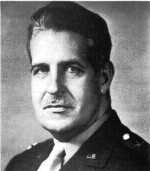
On September 18, 1942 , an order was issued to export from the Staten Island (Staten) 1,250 tons of Congolese uranium ore belonging to Belgium and the next day to buy 52,000 acres of land for future production in Oak Ridge. September 23 Gruvs rises to the rank of brigadier general, and 26 he gets the highest priority for his project.
Back in April 1942, Enrico Fermi in Chicago began to develop the world's first research nuclear reactor. During the autumn, the program for the production of fissile materials for it is transferred from scientists to industrial corporations - DuPont and Kellog Corp. Groves insists on the immediate commencement of preparatory work, despite the fact that the final project for the production of fissionable substances has not yet been completed.
October 15, 1942 Groves proposes Robert Oppenheimer, a professor of physics at the University of Berkeley, who has shown his administrative skills during the work on the S-1 program that preceded the Manhattan project, to head Project Y, a new leading research center for the development of nuclear weapons. Its construction site was approved on November 16 - a place near Los Alamos, New Mexico.

Gruvs power and style of communication did not earn him many friends among scientists. However, he had a good relationship with Oppenheimer, each of them understood how important the other is to the project as a whole.
On December 1, 1942, after 17 days of round-the-clock operation, the Fermi group completed the construction of a CP-1 reactor capable of carrying out a chain reaction. It contained 36.6 tons of uranium oxide, 5.6 tons of uranium metal and 350 tons of graphite.
December 2, 1942 at 15:49 on the CP-1, the first chain reaction took place, the thermal power of which was 0.5 watts. Later, the power at which the reaction remained controlled was raised to 200 watts.
January 1943 - Plutonium production reactors and an enrichment plant for weapons-grade plutonium begin to be built at the Hanford manufacturing site (780 square miles of land near the Columbia River).
March 1943 - as the staff arrives, the Los Alamos research center begins its work.
Until the end of 1943, the creation of a plutonium production plant in Hanford and a uranium enrichment plant (by gas diffusion and electromagnetic separation) in Oak Ridge continued. Also, at this time in Oak Ridge, a large research reactor X-10 is being built, and plutonium will be synthesized in it for further research.
In Los Alamos, the development of a cannon bomb design continued in which two pieces of fissile material approach each other, forming a critical mass. Work on the other principle of obtaining a critical mass, due to implosion (an inward explosion, dramatically increasing the density of the fissile material),
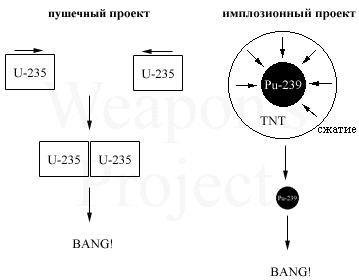
gain momentum by the middle of the year.
In the fall of 1943 , the first unsuccessful attempts to start large-scale production of U-235 on the Alpha Electromagnetic Separator occurred. At the end of the year, a radical modernization of the installation begins.
In the fall, the Alberta project was launched, the purpose of which was to create an army unit capable of ensuring the military use of nuclear weapons. For this purpose, it was planned to change the bombers, training and training their crews.
In 1944, work was simultaneously carried out in three areas:
I. Development of bombs.
Ii. Getting U-235 and Pu-239 on an industrial scale.
Iii. Preparing for combat use.
In January 1944, the main problem faced was the difficulty of creating membranes for gas diffusion installations K-25 in Oak Ridge. Prospects for the creation of such membranes at that time were vague, so Gruvs suspends work on their creation for an indefinite period.
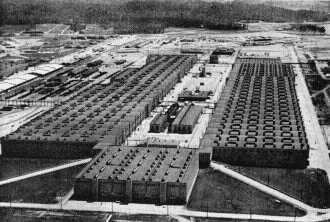
enrichment plant U-235 K-25
At this time, Abelson, who developed a method of enriching uranium using thermal diffusion, learns about the problems with K-25 and suggests Oppenheimer to use his method.
On April 5, 1944 , the first batch of plutonium produced in the X-10 reactor arrives from Oak Ridge. Emilio Segre immediately begins to study the intensity of spontaneous fission of plutonium nuclei. On April 15, he reports that, according to preliminary estimates, the intensity of fission is too large to build a bomb based on the combination of two parts of a critical mass. However, there is not enough information, and the measurements continue.
In mid-May 1944 , six months after the start of intensive research, there was some progress in creating an implosion design of a plutonium bomb. After several reorganizations, the number of specialists involved in this program has increased. New IBM computers, and in addition, two English scientists, Geoffrey Taylor and James Tuck (Geoffry Taylor, James Tuck), have made a serious contribution to the project. Taylor pointed out the problem of instability during implosion (especially Rayleigh-Taylor instability), and Tuck expressed the idea of explosive lenses as a means to form a detonation front wave.
On June 3, 1944, after visiting a uranium enrichment plant at the Naval Research Laboratory, a special expert group recommended the construction of a similar one for the supply of an electromagnetic separator in Ok Ridge.
June 18, 1944 Groves concludes a contract for the construction within three months of the liquid thermal diffusion enrichment plant S-50.
July 4, 1944 Oppenheimer reports to colleagues the final results of measuring the number of spontaneous divisions of plutonium atoms — 50 divisions / kg * s — this is more than 100 times higher than the expected level, too much for the gun charge option.
This discovery was a turning point for Los Alamos, the Manhattan Project, and ultimately for all post-war work. The draft of the gun scheme for plutonium was unsuitable, and Oppenheimer throws all his strength to continue developing an implosion option. Carrying out analytical calculations was replaced, where possible, by numerical methods.
Over the next year, a new detonation front formation technology will be created, made reliable, and a large number of not only engineering but also scientific problems will be solved in the course of the year.
On July 20, 1944, the Los Alamos management decided to attract all available resources to the plutonium project. Instead of the existing state of affairs, when everything was organized around individual scientific or engineering problems, work was now being carried out in applicability to the rifle and implosion charge design schemes, with the latter being given special attention. The reorganization was completed in less than two weeks.
August 1944 . Groves makes the first forecast of the project completion date, presumably the middle of spring 1945.
The Air Force began upgrading 17 B-29 bombers as carriers of atomic weapons.
September 1944 was a difficult month:
The K-25 gas diffusion unit was half completed, but the question of the membranes for it was still not resolved.
Electromagnetic separator Y-12 functioned with an efficiency of 0.05%.
The S-50 liquid thermal diffusion unit at Ok-Ridge partially functioned, but leaks in it prevented it from developing enough power.
There was only one working draft of a nuclear bomb - the uranium rifle version, although the total amount of highly enriched U-235 at that time was only a few grams and there were no proven methods for obtaining it in sufficient quantities.
Plutonium production has not yet begun, although the forecasts on this score were encouraging. The situation reflected uranium exactly the opposite: there was a way to get plutonium in sufficient quantities, but there was no well-established scheme for building a bomb based on it.
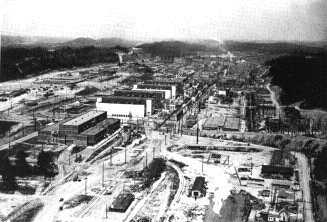
enrichment plant U-235 Y-12
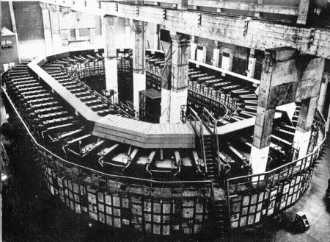
Alpha - the first accelerator on the Y-12

Beta - the second accelerator on the Y-12
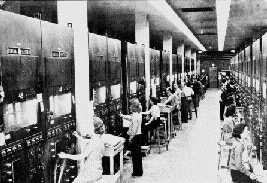
Alpha speed control
The Alberta project entered a new phase when Air Force Lieutenant Colonel Paul Tibbets began the organization of a 509 unit, which was to use atomic weapons. This unit exists to this day as a strategic bomber force of the United States Air Force.
On September 26, 1944, the first full-size plutonium production reactor, B-pile, was completed and loaded with uranium. It contained about 200 tons of metallic uranium, 1200 tons of graphite and was cooled with water at a speed of 5 cubic meters / min. Its design capacity is 250 MW and 6 kg of plutonium per month. But there were no surprises here. On this day, E. Fermi gave the command to start. After several hours of operation at 100 MW, the reactor power spontaneously fell for an inexplicable reason, and the next day the power spontaneously increased. The reason for this became clear in a few days and was that among the fission products of uranium was gas Xe-135, which is an active neutron absorber. He caused a decrease in power. The B-reactor and the reactors still under construction were modified to overcome this difficulty.
On October 27, 1944, Oppenheimer approved a future test in the Jordada del Muerto Valley (Jornada del Muerto), the Alamagordo testing ground in New Mexico. Groves approves the project five days later.
The end of 1944. By the end of the year, the situation is as follows:
Y-12 is producing 40 grams / day of highly enriched U-235 by November and 90 grams / day by December.
In mid-December, the first successful tests of detonation lenses strengthened confidence in the creation of an implosion bomb project.
On December 17, the second plutonium D-pile reactor starts operating. It is time for large-scale plutonium production.
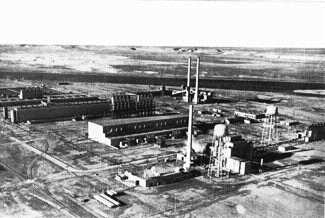
D-pile plutonium production reactor in Hanford
In 1945, the project goes to the finish line:
January 1945.
Y-12 goes on production 204 grams / day 80% U-235, a sufficient amount of material (~ 40 kg) is planned to receive by July 1.
Diffusion plants in K-25 receive suitable for use membranes, are loaded with uranium hexafluoride and begin to work.
January 18 in the experiment "Dragon", conducted by Frisch (Frisch), achieved a critical configuration of the fissionable substance due to fast neutrons. The highest power output was 20 MW in 3 ms, which raised the temperature by 6 ° C.
February 1945.
In Hanford, he earned another plutonium reactor - F.
The project of a uranium bomb is fully completed and approved. Planned deployment and combat use of a single copy of the bomb.
Plutonium comes from Hanford.
The Pacific island of Tinian is chosen as the base for the atomic attack.
At a meeting between Oppenheimer, Grooves and the heads of departments of the Los Alamos laboratory, on February 28, an approach to plutonium bomb was discussed.
March 1945.
Thermal diffusion installation S-50 begins to function.
March 5 Oppenheimer approves the project of implosion lenses for the plutonium charge.
By the middle of the month, the first results of compression observations during implosion appear.
April 1945.
April 3 at Tinian begins preparations for the deployment of a 509 US Air Force compound.
April 11 Oppenheimer reports on the performance of implosion compression in mini-tests.
April 12, President Roosevelt dies of a stroke.
April 13, President Truman is informed of the existence of a project to create atomic weapons.
April 25th Truman receives the first detailed report from Stimson and Gruvsa.
On April 27, an initial list of targets for bombing is created. It included 17 targets, including: Tokyo Bay (for demonstration), Yokohama, Nagoya, Osaka, Kobe, Hiroshima, Kokura, Fukuoka, Nagasaki, Sasebo. Many were later excluded from the list, as they were subjected to a strong conventional bombardment.
May 1945.
May 7th. In order to calibrate the recording equipment, a “100-ton test” is carried out - undermining 108 tons of TNT / hexa mixed with radioactive substances with a total activity of 1000 curie. The explosion is made at 730 m from the site of the future test Gadget'a
May 8 The capitulation of Germany.
May 10. The list of targets has been shortened to: Kyoto, Hiroshima, Yokohama, Kokura arsenal.
In mid-May, the Little Boy was ready for use, with the exception of the uranium core. The required amount of uranium is expected to be received no later than August 1.
May 25 The invasion of the Japanese island of Kyushu is scheduled for November 1.
May 28th. The Target Committe targets committee includes Lieutenant Colonel Tibbets. According to Tibbetz’s forecast, by January 1, 1946 most of the Japanese cities will be destroyed by bombing. The list of possible targets for an atomic strike varies: Kyoto, Hiroshima, Niigata.
May 30. Stimson excludes Kyoto from the list of intended targets.
June 1945.
June 10th. 509 Aviation with the modified for carrying nuclear weapons B-29 begins to arrive on about. Tinian
June 24. Frisch, after critical tests, confirms the suitability of the implosion core.
At the end of the month, LeMay estimates that the 20th Air Army will destroy 60 major cities in Japan by October 1.
July 1945. This month, the final preparations for the test, called Trinity, are being held, scheduled for July 16 at the Alamagordo bombing site, New Mexico.
3 July. Finished casting a U-235 projectile for the Little Boy; on July 24, the production of a uranium target will be completed. On August 6, this bomb will be used during the first atomic bombing in Hiroshima.
July 7th. Finished making explosive lenses for a plutonium bomb.
July 10th. The best lenses available are selected for Trinity.
July 11th. The atomic charge assembly “Gadget” begins.
July 12,13. The plutonium core and the rest of the Gadget components are sent from Los Alamos for final assembly near the 0 polygon mark. Assembly takes place July 13 from 13:00 to 17:45. During this time, set explosive lenses, uranium reflector and plutonium core.
the 14 th of July. Gadget is raised to a 30 meter tower, installing and connecting detonators.
The Little Boy is shipped in parts from San Francisco to Tinian.
July 16, 1945. At 5:29:45, the successful test of the Gadget charge is made. Explosion power: 20-22 kT.
Members
The project participants are physicists and other world-renowned scientists: Rudolf Peierls, Otto Frisch, Edward Teller, Enrico Fermi, Niels Bor, Klaus Fuchs, Leo Szilard, John von Neumann, Richard Feynman, Joseph Rotblat, Isidor Rabi, Stanislav Ulem (Yulem) , Robert Wilson, Victor Weisskopf, Herbert York, Kenneth Bainbridge, Samuel Allison, Edwin Macmillan, Frank Oppenheimer, John Lawrence, Georgy Kistyakovsky, Hans Bizet, Ernest Lawrence, R. Roberts, F. Mohler, Alexander, Hans Bizet, Hans Bizet, Ernest Lawrence, R. Roberts, F. Mohler, Alexander, Hans Bizet, Ernest Lawrence, R. Roberts Bush, Eckers, Halban, Simon, E. Wagner, Philip Hauge Abelson, John Cockroft, Ernest Wo tone, Bob Wilson.
Sources:
1. http://atomas.ru/milit/manhattan.htm
2. http://pobeda.rambler.ru/photo_popup.html?id=6044&countryid=207&type=images&index=3
3. http://en.wikipedia.org/wiki/%D0%9C%D0%B0%D0%BD%D1%85%D1%8D%D1%82%D1%82%D0%B5%D0%BD % D1% 81% D0% BA% D0% B8% D0% B9_% D0% BF% D1% 80% D0% BE% D0% B5% D0% BA% D1% 82
Source: https://habr.com/ru/post/69464/
All Articles